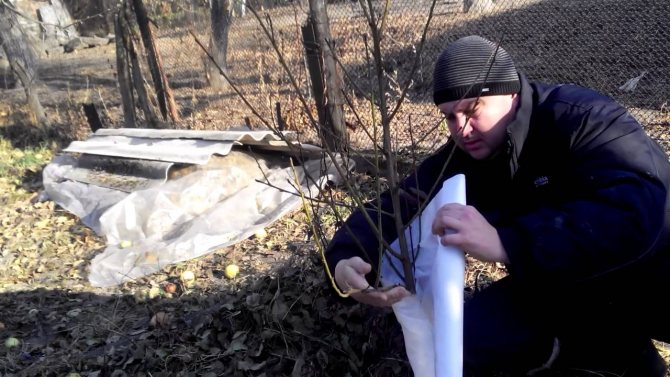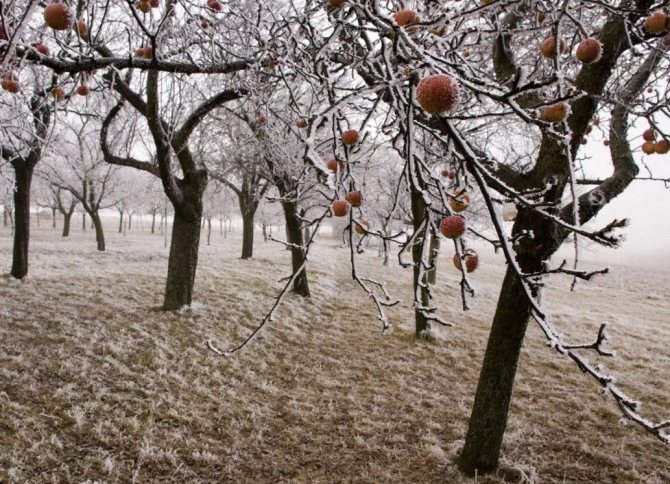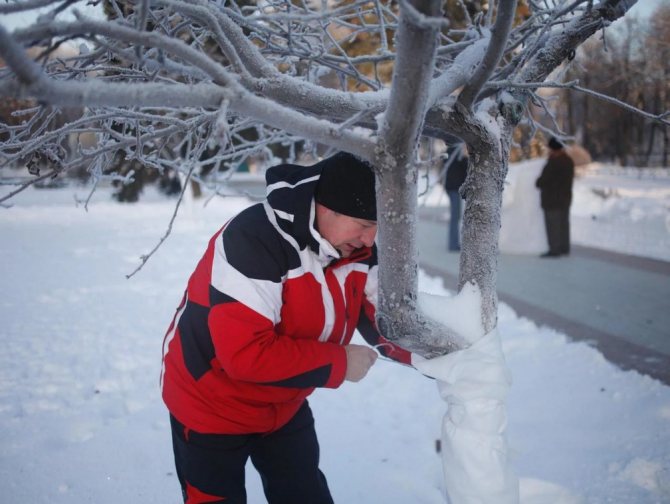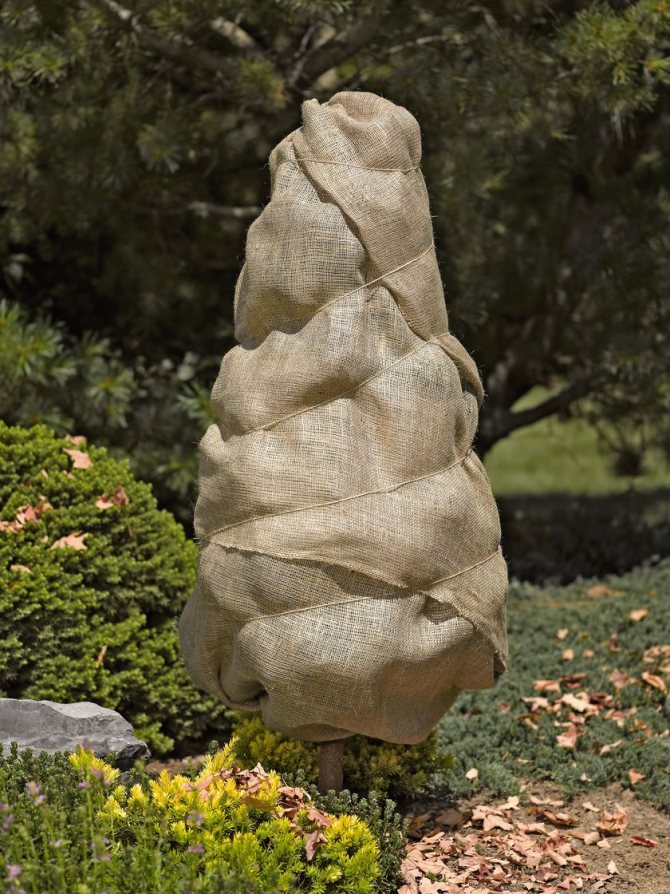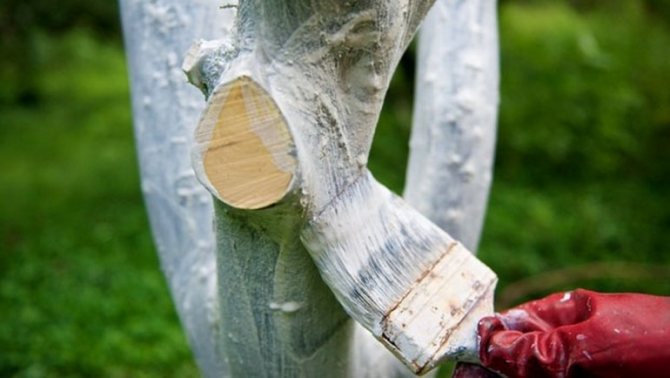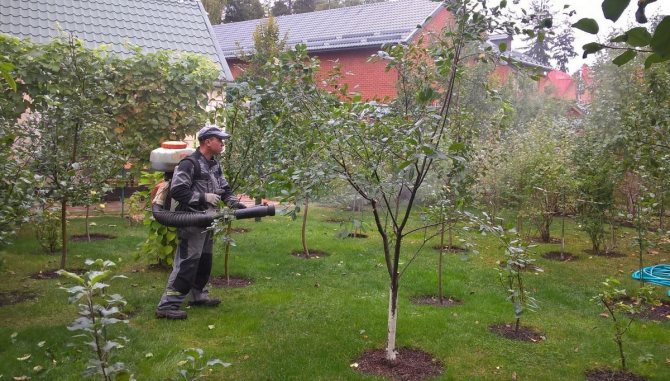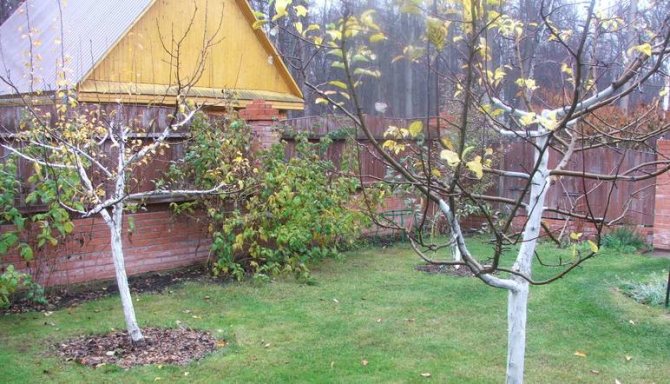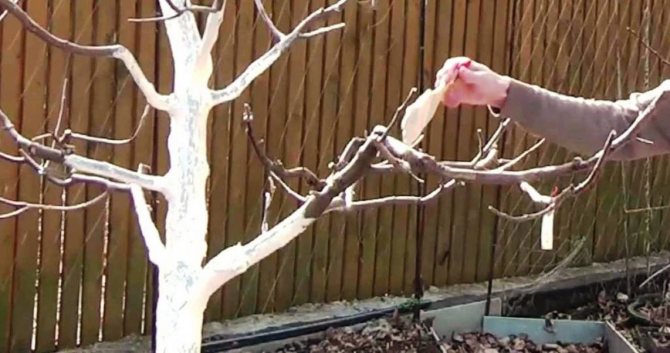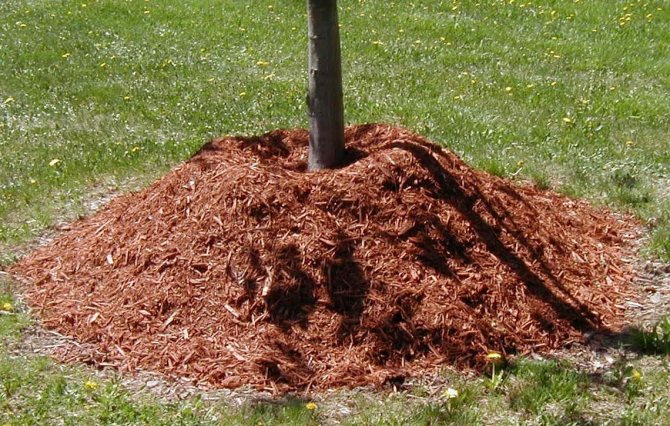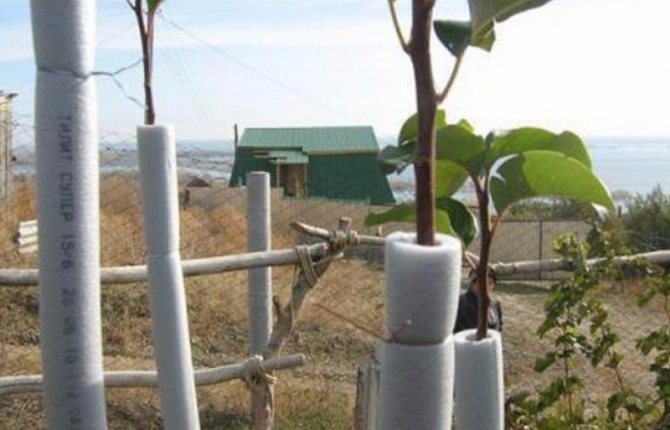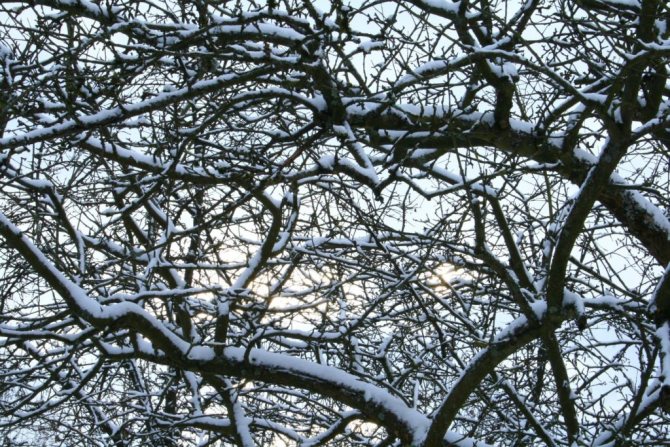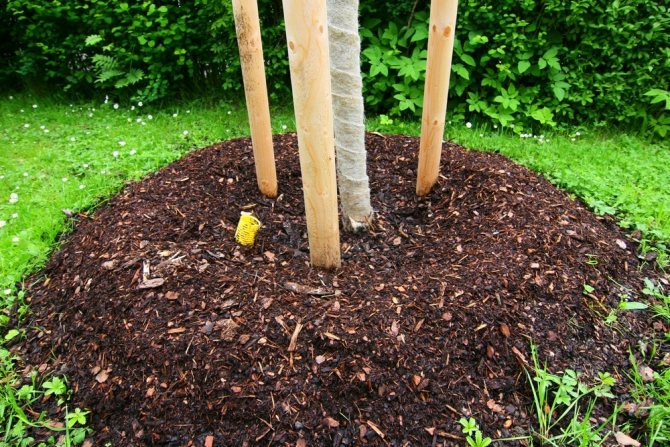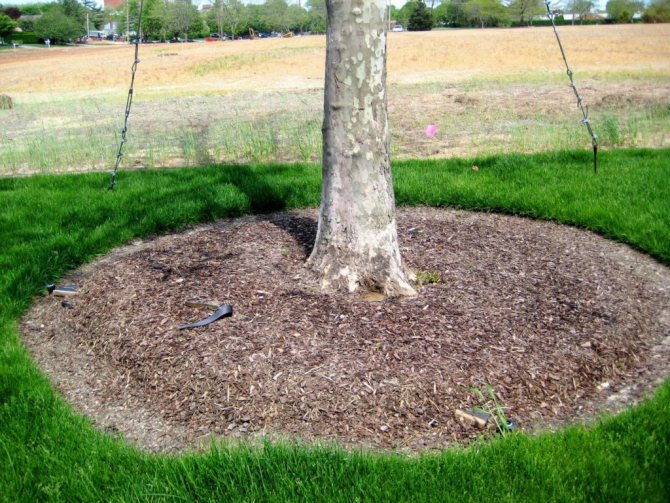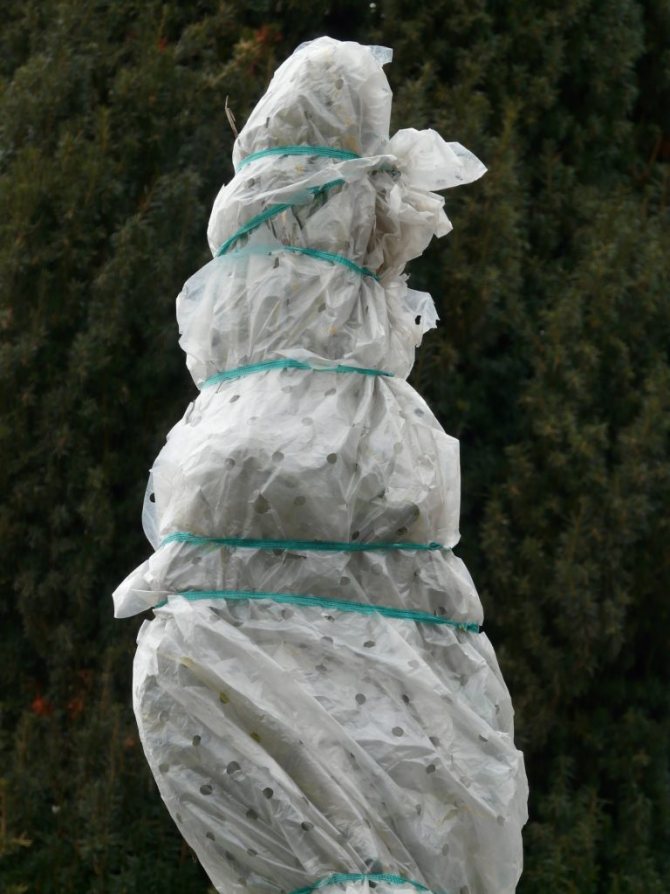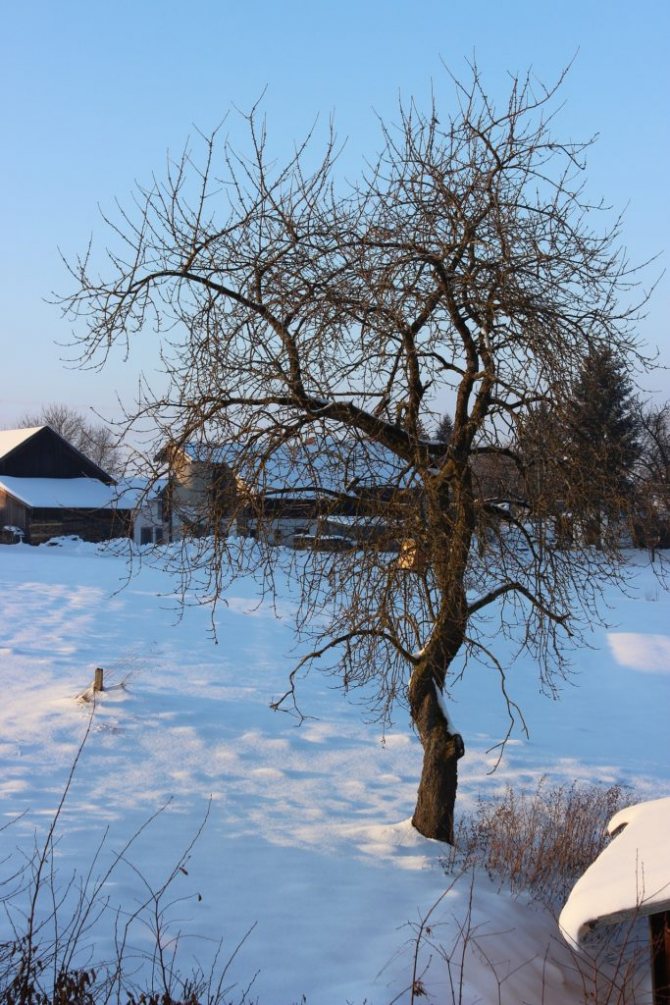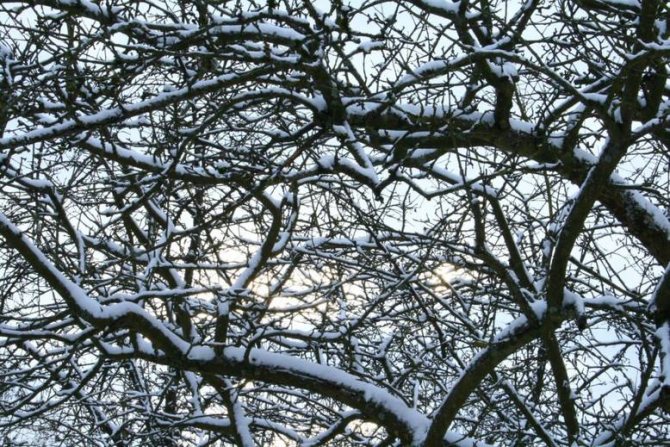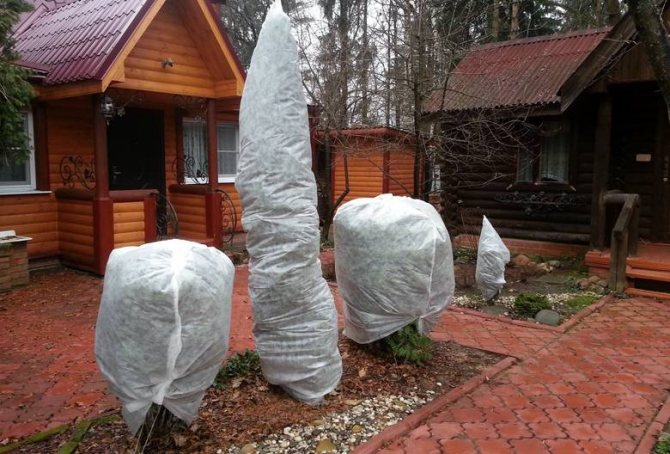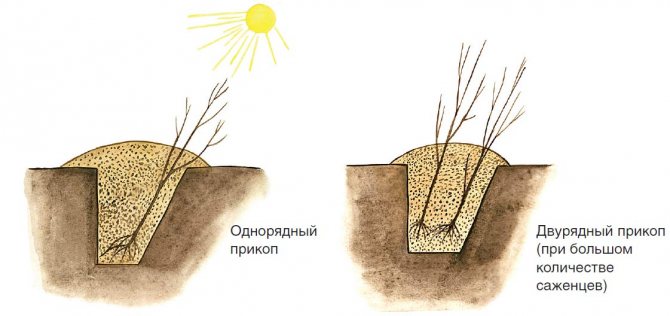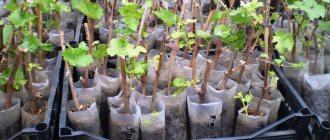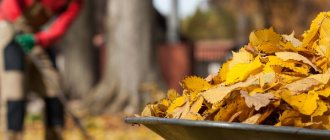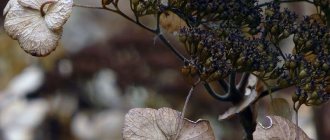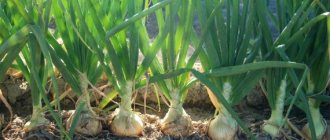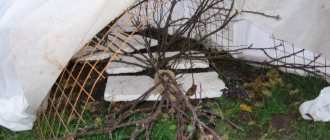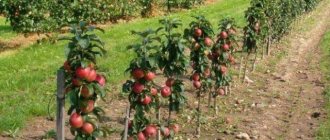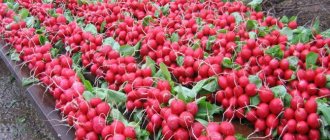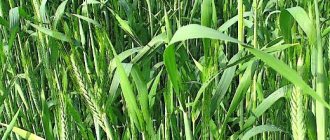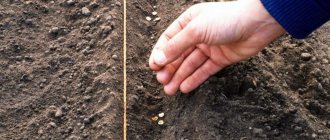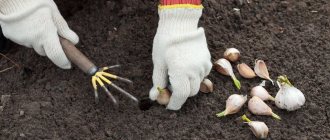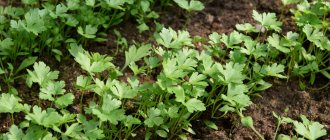What materials are better
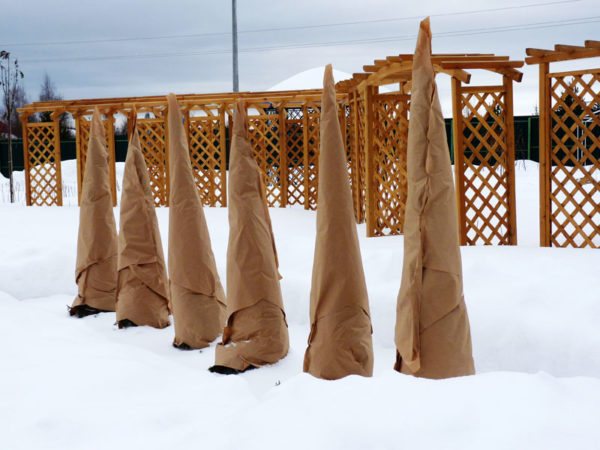
For shelter from the cold, you can use both natural materials that you can collect yourself, and special synthetic fabrics, canvases. The former are distinguished by an affordable price, the latter - by their durability and efficiency. In the middle lane, the soil and roots are covered with sawdust, spruce branches and withered foliage. To achieve good thermal insulation, it is necessary to lay them in several layers, but in the spring these materials will begin to give useful elements to the soil and will not interfere with active air exchange. Under such a shelter, the soil will not vanish, the risk of developing fungus and mold is minimal. However, these materials will not save from severe cold weather; without additional reinforcement, they will quickly be blown up by the wind, especially in open areas.
Warming young trees with agrofibre is a more common and reliable measure to protect them. Non-woven fabrics are moisture-permeable, so there is no greenhouse effect. At the same time, numerous small pores do not allow air to quickly seep through the layers, even a strong wind is not terrible for such a shelter. Agrofibers can be used for several seasons. Inexpensive options can be spoiled by rodents and pests, and they will thin out over time. Dense rubber-impregnated products should be avoided, moisture will surely accumulate under such products.
Among the heaters, materials such as matting, felt are distinguished. They have the best thermal insulation characteristics, however, they are the least durable. Just one layer will be enough to protect the roots and even the trunk from severe frost. It is not difficult to use such shelters correctly, their price is not too high. But after one season, you will have to buy insulation again.
Features of the regions
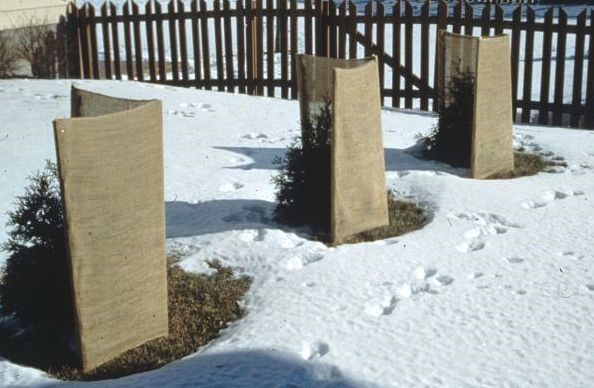

No matter how reliable the thermal insulation is, if the roots or trunk are already damaged by the cold, and the soil has had time to freeze, the tree may die. Therefore, it is very important to choose the right time to process the plantings. It depends on the climatic conditions in the region.
In the southern strip, it is enough to mulch the soil in time and cover the trunk from pests. This can be done until the end of November. Additional protection is required only for those seedlings that were planted late. It is imperative to cover capricious varieties, tropical plants that must acclimatize for several years.
In the Moscow region, the middle lane, the Volga region, it is necessary to complete all measures for the preparation of plantings before the beginning of November. In the middle of the month, at night the temperature already drops below zero, but snow falls extremely rarely during this period. You can only use simple tools at hand, if the forecast for the winter is not too frightening. Processing is carried out in several stages:
- pruning;
- mulching;
- barrel insulation;
- covering the roots with sawdust or spruce branches;
- pouring snow.
In the Volga region, due to strong winds and high humidity, it is recommended to use agrofibre, matting or felt for additional protection, but this is not necessary if there is enough snow for a reliable shelter.
In the northern regions, it is necessary to insulate the entire tree, including large branches, before the end of October. The first layer of root cover must be reinforced with heavy spruce branches or not too thick boards.Additionally, snow is raked into the root circle. The trunk is insulated significantly, in several layers.
Gardeners need to take into account that earlier shelter can harm the plant, especially in warm regions. Therefore, it is important to adhere to standard deadlines. For example, you need to determine the shelter time of an apple tree by the average daily temperature. Preparation begins when day and night totals are approaching a stable 10 degrees. Up to the zero mark, the plants will be able to survive the cold snap, but by this time they need to be completely insulated. For example, in the Moscow region this is the period from late October to mid-November, in the Urals from early October to early November, in Krasnodar - the second half of November and early December, and in the Far East from early October to mid-month.
Warming of adult plantings
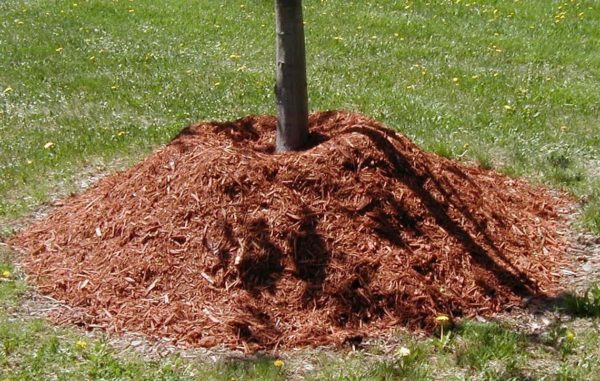

Adult, large trees need protection, if the prognosis is unfavorable, they have suffered diseases in the current year. A small shelter is always desirable, since this will allow you not to lose the achieved yield, even under the most unfavorable conditions in the next period. And if it is difficult to damage adult plants with winter frosts, then the first cold without snow, late spring temperatures below zero are even more dangerous.
Preparation
The preparation of mature fruit trees for the winter should begin with pre-treatment. First of all, you need to harvest the entire crop, be sure to dispose of all rotten, spoiled fruits. Fallen leaves need to be scooped up. They can become a source of soil contamination and new shoots in the spring. You also need to take care of pests. An effective measure for the prevention of infection will be processing:
- a solution of copper sulfate;
- lime concentrate;
- a weak solution of potassium permanganate.
If the insulating material is not used for the first time, after storage it must be dried and treated with the same composition in order to exclude infection. To prevent rodents from entering the shelter and roots, you can use a simple remedy such as coffee grounds. The pungent smell scares off even harmful slugs and snails, large animals. All of them come to the gardens in winter in search of food. Whitewashing with a special compound or lime will also make it difficult for rodents to access the bark that is tasty for them. Enemies of wood are small insects, ants will not be able to penetrate the cracks and harm the plant. In addition, such a measure will avoid cracking of the rough bark of the adult trunk due to temperature changes.
Thermal insulation of the trunk circle


Mature garden trees need shelter for the trunk circle. Developed roots can be damaged by frost, so it is imperative to mulch the ground. Pre-treat the soil with a weak fungicide solution. Distinguish between permanent and dynamic mulch. Constant also performs a decorative function, but in cold regions it is recommended to first perform dynamic processing, for which they are suitable:
I put manure and ready-made compost in a layer no thicker than 6 centimeters. Otherwise, rotting can begin. All other materials can be laid in a layer up to 10 centimeters. The processing of seedlings is carried out in a similar way.
Permanent mulch is a coating of the soil with durable materials with good thermal insulation properties. For example, gravel with different grain sizes, coarse sand, natural stone chips. If it is desirable to cover the dynamic mulch with spruce branches or agrofibre, then the permanent one no longer needs further strengthening. The only exception is the northern regions, where layering is needed to protect against severe frosts.
Insulation of the trunk and branches
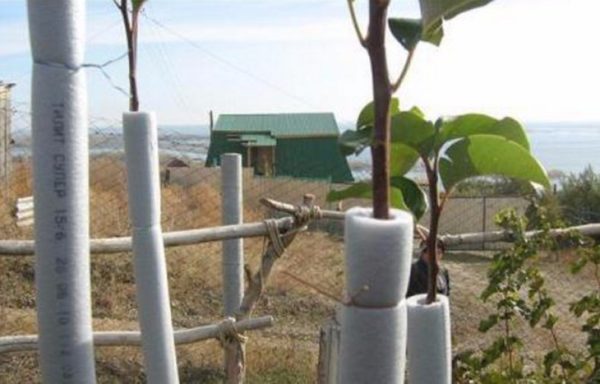

Adult plants need to be completely insulated only in the northern regions. If temperatures do not drop below minus 30 degrees Celsius, the strengthened trunk with thick and coarse bark will cope with the load on its own. Such wood insulation is already enough.However, if the plant has been infected, weakened, recently transplanted, it makes sense to cover the trunk additionally, but then remove all materials a little earlier to ensure timely awakening in spring.
Preparing fruit trees and shrubs for winter
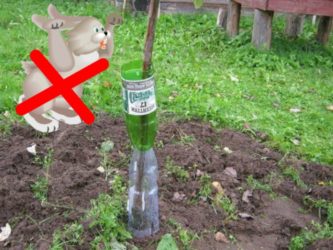

Successful wintering is the main condition for the productivity of an orchard. Only a miracle can moderate the winter sun, temperature changes and the appetites of pests. But if you properly prepare the garden for winter, you can increase its resilience.
In August, feed trees and shrubs with fertilizers containing phosphorus and potassium. These elements help to increase the winter hardiness of all parts of plants. You can use superphosphate, double superphosphate, potassium sulfate and add the dose recommended on the package to the trunk circle.
But trees are more responsive to foliar feeding (spraying foliage with a weak solution). For them, it is better to use readily soluble fertilizers.
Among the phosphorus-containing, there are very few of them, and perhaps the best for this purpose is potassium monophosphate, it contains both components necessary for plants to prepare for winter.
The root system of fruit trees can withstand temperatures down to –16 ° C; in dwarf and semi-dwarf rootstocks, the frost resistance limit is several degrees higher. Under the snow, the temperature does not drop to such values, but frosts without snow are very dangerous. Trees with frost-damaged roots do not die immediately.
In the spring they begin to bloom (although later and more slowly than healthy ones), they can even bloom, and die in the summer. Finding that a tree is lagging behind in development, you can still hope that the roots are not completely damaged.
Watering and treatment with stimulants with root-restoring properties ("Zircon", "Kornevin", "Heteroauxin", HB-101) will help to bring it back to life.
General cleaning (August-September)
Harvest in time, do not leave shriveled, diseased and twisted fruits on trees - these are sources of pathogens.
Peeling (September)
Remove old bark and lichens from the trunks. This is needed for trees older than 6–8 years old, in which the upper layers of the bark begin to peel off and die off. This is a natural process for any tree, and you should not be afraid of it.
You can clean the bark with metal brushes and a tool for removing grass between the plates (its sharp corner is convenient for working in hard-to-reach places). Work carefully, removing only the outer layers of brown and black. The living bark has a delicate light green hue. Remove lichens at the same time.
By themselves, they do not harm the tree, but serve as a shelter for pests and pathogens. To get rid of lichen, you can spray the trunks with iron sulfate. Drying out, the lichen will acquire a brown color, but you will still have to manually remove it from the surface of the bark.
The vitriol treatment is best done in late October - early November, since the solution can damage green leaves.
Hardening and mulching (September-November)
If you have young apple trees of valuable varieties, grafted on a vigorous seed stock, and pears, you can harden the root system - this will increase their resistance in case of snowless frosts.
In September, shake off the soil from the trunk of the tree 3-5 cm deep, exposing the upper part of the large roots. Collect the removed soil and store it dry in a frost-free room.
With the onset of light frosts, return the earth to its place.
Thanks to hardening, the roots will gradually get used to low temperatures and survive the dangerous period before snow falls more successfully. The root system of apple trees grafted on a semi-dwarf rootstock, as well as stone fruit trees, will be protected from frost by mulching the soil with dry bulk materials. It is held in November.
Moisture-charging irrigation (beginning - mid-October)
Water the garden thoroughly when the leaves fall.The root system consumes moisture until the soil freezes. If the autumn is rainy, there is no need for watering, but when there is little rainfall and the ground does not freeze for a long time, the plants may suffer. Irrigation doses depend on the age of the plant: the ground at a depth of 40 cm (for trees) and 20-30 cm (for shrubs) throughout the crown projection should be wet.
Shelter of young trees
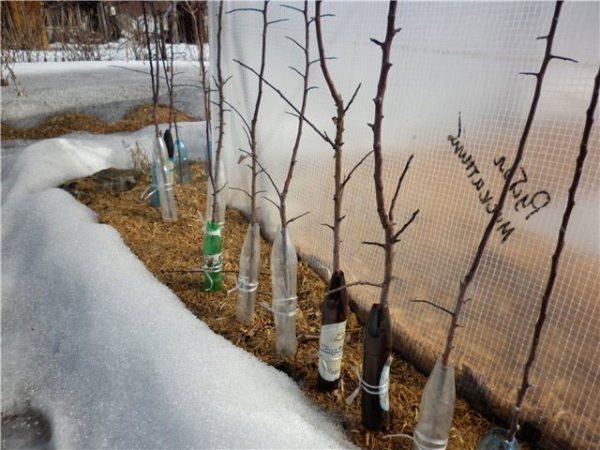

Young plants must be protected from frost, since their roots are not yet too strong, and the trunk has not yet been covered with a thick layer of perennial bark. Such annual processing will allow you to get the first crop several years earlier. This is especially necessary when planting trees that are nonspecific for such a region, thermophilic. Often, gardeners are faced with the fact that young plantings "rest" and do not bloom. Often this is due precisely to hypothermia. A reliable shelter will allow you to quickly form a crown and a lot of fruitful branches.
Warming with thick tights is a good option. It is desirable that these are products with natural fibers. Such protection can, in general, not be removed from the trunk and branches for the first few years. Synthetics are poorly permeable to air and moisture, so it is better not to use them. Warmed models are best suited. The technology of winding and securing is simple, you can master it from one of the many videos.
The first stage of processing is the insulation of the periosteal circle and its mulching. Then the whole tree is wrapped with a layer of the chosen material or tights. If there are thin and flexible branches, they can be pressed against the trunk. Everything is strengthened and tied with twine or tape. If necessary, they are additionally covered with spruce branches, slightly going onto the trunk itself. Then, when snow falls, a thick layer is thrown. In the spring, it will become an additional source of moisture for the warming soil.
How to prepare a tree for winter
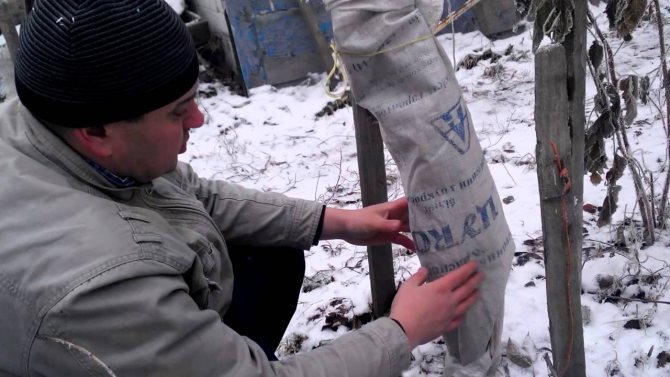

Before covering a bole of an adult tree or a young seedling, it is necessary to properly prepare them for an important agrotechnical event.
Stages of preparing apple trees for winter in Siberia:
- They dig up the soil in the near-trunk circles and apply fertilizers - potash or phosphates. Nitrogen fertilizers are prohibited during this period. They provoke the growth of green mass. The tree will continue to grow and, not having time to "hibernate" before winter, risks dying.
- Cut off old, diseased and damaged branches. Young growth is cut by 2/3. The height of the tree after pruning should be no more than 3.5 m. Crossed shoots directed towards the inside of the tree, thickening the crown, as well as root shoots are removed.
- At the end of August, the tree is watered abundantly - for the last time in the season. Watering is stopped to slow down root growth.
- In the fall, remove plant debris and branches in the trunk circles. You cannot leave the leaves - insect larvae hide in them.
- They clean the bark with a special garden brush, spreading a film under the crown. All garbage, along with insects, is burned. Scratches are smeared with garden varnish.
- The boles are painted with lime dissolved in water, and the crown is sprayed with vitriol - copper or iron.
Insulation of seedlings
It is not advised to root seedlings in winter if they are not frost-resistant varieties. Otherwise, it is better to postpone the procedure until spring. If a young seedling is already dug in, a little stronger, cover it using the same technique as any other young tree, but at the same time layering is used even in warm climates.
How to dig in correctly
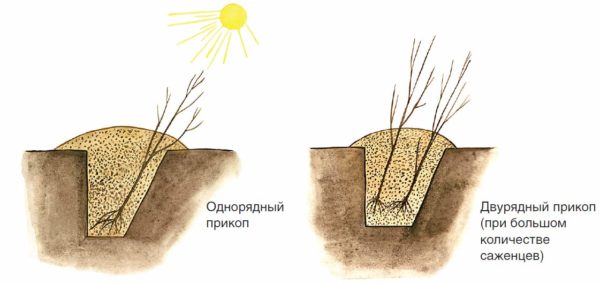

In the garden, you can arrange a full-fledged shelter for seedlings that have not been planted. Placing them in a special groove is called a digging hole. They choose a place where water does not accumulate in spring, away from bushes, dung heaps and buildings. They dig a trench 40-60 centimeters deep. Better to do it in the direction from west to east. The northern slope is dug gently, and the southern slope is 50-60 degrees.
The seedlings are pre-inspected, soaked in water with an antiseptic solution. Twelve hours is enough to saturate them with moisture and kill all pests. In a trench, they are laid with roots to the north, crowns to the south. The optimal distance between the trunks is 30 centimeters. It is necessary to cover seedlings with soil gradually. First, the voids between the trunks and under them are filled, slightly moistened, then the northern side near the roots is filled, spilled again with water, after which complete cover is performed. When the trench is completely buried, it must be lightly tamped without much effort. From above, the soil is covered with a mixture of peat and sawdust, covered with agrofibre. The branches themselves can be additionally protected with spruce branches or straw.
Shelter of conifers
Young Christmas trees are sensitive not only to frost, but also to the load of snow. Therefore, you need to start sheltering in the garden by tying the branches. They are gently pressed against the trunk and tied with twine without strong tension. The near-trunk circle is mulched and covered, the trunk itself is covered with the selected material. If possible, you can build a triangular frame around the seedling, filling the inner space with bags of straw. This is a reliable protection for the youngest trees from rodents and from severe frosts.
It is permissible to cover conifers and polyethylene, various perennial films. In this case, it is imperative to build a frame around the trunk. Such materials are not fixed directly to the branches, since the needles will inevitably ripen, and subsequently rot.
Shelter for fruit seedlings
If the seedlings have already been planted, it is impossible to dig them into the trench, it is necessary to strengthen the protection measures against cold and pests. The trunk and branches are tightly wrapped with synthetic agrofibre in several layers. Additionally, a layer of felt can be placed between the fabric and the bark. You need to close the entire height, all small branches, otherwise they will not be able to overwinter. The trunk circle must be covered with spruce branches or straw, mulching alone is not enough.
It is advisable to wrap a young fruit tree sapling with a thick layer of protection from wind and cold air. It can be either a film or roofing material. This layer of insulation must be removed at the onset of the first thaw.
Sheltering trees is a simple procedure that can be carried out for a long month before the first cold weather. You should not rely only on snow cover. Even coniferous and frost-resistant species overwinter in a shelter. Multi-layer protection allows you to avoid penetration of various rodents to the trunk and young branches, which can lead to the death of plantings. The use of natural materials will reduce waste, and the use of special agrofibre will provide reliable thermal insulation even in the most severe climates.
Garden young apple trees require special care and protection for the winter. Fruit trees can be damaged for various reasons. How to cover a young apple tree for the winter, so that in the spring, when you return to the garden, you do not have to find dead trees that will not be able to give a crop.
How to insulate bushes for the winter. Mi. Absolutely all plants on the site need shelter
Any plant has the ability to adapt to environmental conditions and climate. If you do not grow completely exotic plants, "guests from southern countries", then in most cases you do not have to worry - other perennials will endure winter frosts and lower temperatures. Most of the plants are zoned, i.e. Hardened and prepared to grow in the area in which you grow them. Basically, delicate perennial plants need shelter, which primarily include:
Often exotic plants are kept in containers. Lemon or olive trees should also be protected in winter. With fleece or bamboo mats around the pot bales, exotic plants for wintering potted plants are also available.Thus, the expert not only makes the trees hardy, but also protects all of your plant splendor within a few steps.
Winter trees are just as important as preparing your plants and shrubs for the winter. With the right preparations, advice and professional help from a gardener, your trees can survive the cold winter in peace! Winter plant protection; The weather is a factor that the person in the garden has no control over. From time to time, a cold grip will kill many plants.
- roses (almost all types, except for park ones);
- clematis;
- chrysanthemums;
- lilies;
- garden peonies;
- rhododendrons;
- lavender;
- grapes;
- young thuja up to 5 years old.
Many of them, like fuchsias, die off above the ground, but the roots survive, and new shoots grow in the next year. However, if severe frost persists, the soil may freeze as well. Then the roots come in too. Sometimes it is just frost, as some plants cannot withstand such low temperatures. Sometimes this happens because the plant in the frozen soil can no longer absorb moisture. Even in winter, plants can die of thirst. it is usually best to get through the winter when the summers are warm and sunny and the wood may have hardened.
Winter plant protection that distracts frost
After cool, humid summers, softwoods are more sensitive to frost. Remove dead or frozen plant material above the ground. Frost in place is often caused by cold air blowing away the descent and dammed up by hedges or depression. It forms a frost pocket or freezes a pit. But you can prevent this from happening.
Why do you need to cover apple trees
Many novice gardeners believe that apple trees need to be covered solely for protection from frost. But it is not so. Of course, young apple trees can freeze in severe frosts, but not only this threatens them. The main reason why such a shelter is needed is protection from rodents, which very often feast on the juicy bark of seedlings.
Insulating the trunk will help protect the bark from the piercing wind, which can dry it out. The spring sun can also harm apple bark, it can cause burns. The quality of the harvest and the fruitful period depend on how competently the measures for sheltering the apple tree for the winter are carried out. A young apple tree, deprived of shelter, may die, its skeletal branches will freeze, and the root system may freeze out. This is especially true for apple trees grown in Siberia.
If the bark of an apple tree is damaged, it will not be able to develop normally and grow in spring. There won't be a good harvest either. The bark, which has lost its integrity, is susceptible to diseases, which can lead to the death of the tree. Protecting the bark by covering it for the winter is an important task for the gardener who takes care of his garden.
Why do you need to cover young trees?
In winter, fruit trees enter a period of relative dormancy. They look lifeless, but this is not so - the roots still continue to feed the trunk and crown, although not as actively as during the growing season.
Young trees are more susceptible to negative influences, so they need additional protection. Their further growth and yield depends on how the grown seedlings survive the winter.
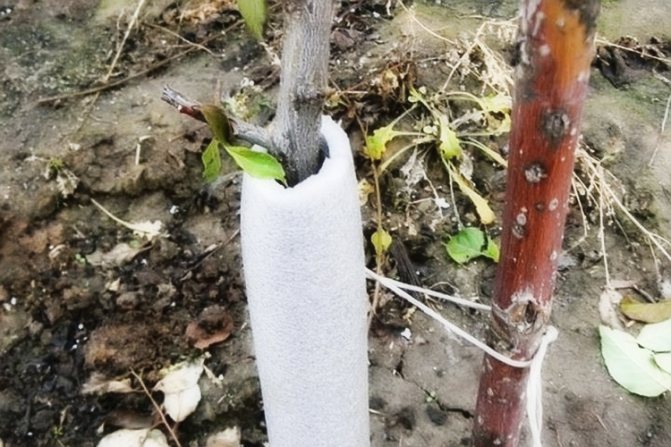

What will give timely and high-quality shelter of young trees?
- Frost protection. Due to the low temperature, a lot of seedlings die, and those that partially freeze develop poorly and get sick much more often.
- Such a shelter will prevent cracks and damage to the bark. Young trees have not yet formed a sufficiently dense bark, and it is very easy to damage it. And cracks lead to plant deformation, disease and weakening.
- Rodent protection. Hares, mice, voles and rabbits are the worst enemies of trees in winter. They eat up the bark, the plant weakens and may not survive the cold.Rodents are especially dangerous in February and March, when their main food supply ends and they go out to feed in the gardens.
The age after which the apple trees no longer need additional shelter for the winter varies depending on the variety. Frost-resistant varieties require 4 - 6 years, but it is better to continue insulating columnar apple trees for the winter and beyond. In some regions, all fruit trees are insulated, since frosts there can destroy even an adult and strong plant.
When and how to cover a young apple tree for the winter
It is very important to correctly determine the timing of sheltering apple trees for the winter. The health and life of fruit trees depends on this. If you cover the apple trees too early for the winter, young shoots will start growing too early. The first-year apple tree, insulated too early, will surely start growing. This should not be allowed as the plant will die. It is recommended to carry out measures to insulate the apple tree when the sap flow completely stops, and a steady cold is established outside with an air temperature of about -10 degrees. Before sheltering apple trees for the winter, you need to clean the trunks and branches from the old bark, which peels off, and then whitewash with a lime solution.
Time to prepare apple trees for wintering
It is impossible to determine the exact date of the organization of the winter protection of apple trees. The timing of the relevant events depends on many factors - climatic conditions, the location of the garden area, etc.
Experienced gardeners are advised to shelter apple trees for the winter during a period when a persistent frosty air temperature (-10 degrees) is established outside. If the trees are wrapped earlier, then under the influence of heat they can begin to grow and bud, which in the future (when the cold comes) will cause their death.
Materials for sheltering apple trees for the winter
How to cover the apple trees? Air-permeable materials are suitable for covering the root collar. You can take a regular old stocking. To protect the tree trunk, burlap, old rags, sugar bags, from which you must first remove the film, are suitable. You can use regular newspapers. Together with the stem, it is necessary to cover the lower branches. Agrofibre is an excellent material for warming apple trees, but expensive. It protects trees from frost and rodents. Agrofibre is easy to buy.
In the old days, fruit trees were protected with straw, corn stalks, reeds, branches of coniferous trees. And now these materials can be used to shelter apple trees. You need to be careful with reeds, they often get mice. It will not be superfluous to spread poison around the apple tree if reeds are chosen as insulation.
Many gardeners use ordinary plastic bottles to cover their apple trees. This is an accessible material for everyone. They reliably cover the root collar and stem, and also perform the function of scaring off, since they make noise with each breath of wind.
The most unusual shelter material is toilet paper. You just need to choose the cheapest and coarse varieties of it. Wrap the root neck in several layers with toilet paper. It is necessary to capture the stem and the lower branches. You will need at least three coats, the more the better. To prevent the paper from being ripped off by the wind, it is fixed with twine.
Foamed polyethylene for thermal insulation of pipes will help insulate the apple tree for the winter. To do this, it is cut along the seam and put on a tree. It can be fixed with tape or twine for a better hold. With such a heater, the tree will not be cold, and rodents will not get to the trunk. And such a shelter looks aesthetically pleasing. The cost of such material is very low, and it can be used many times.
You can use a film or roofing material, but they cause backing.They are airtight, if such material is not removed in a timely manner in the spring, wait for the greenhouse effect, the trunk will burn out, a fungus will appear on the tree.
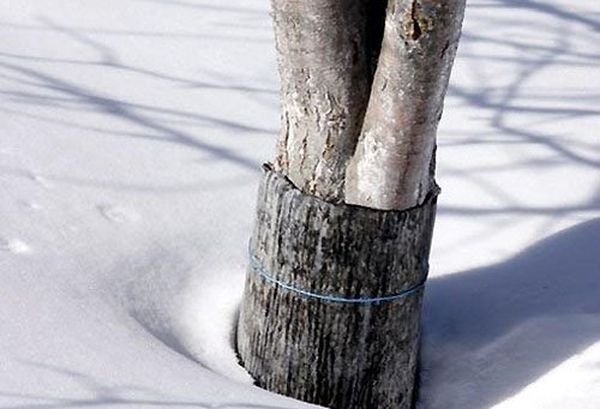

How to cover young apple trees for the winter: technology
How to cover apple trees? Various methods can be used to cover trees. They depend on the variety and age of the trees. Young trees need careful and careful shelter. First you need to cover the peri-stem circle with insulating material, then cover it with snow. To better keep the snow near the tree, you can throw in tops or small brushwood.
After the first snow cover appears, experienced gardeners advise using it to cover the crown of an apple tree. Snow is taken from paths where there are no plants. During the winter, it is necessary to monitor changes in the weather; the apple tree should always remain under the snow. Uncut shoots can remain open. Covering material is removed only when all the snow has melted. An exception is plastic wrap or roofing felt. These materials are removed at the first thaw.
To check how the apple tree survived the winter, you need to cut off the tip of the branch and look at the cut. A branch is alive if there is a white tissue in the section. When purchasing fabric of a beige or brown shade, we can definitely say that the branch has died. When one or several branches die, one cannot speak of the death of the entire tree.
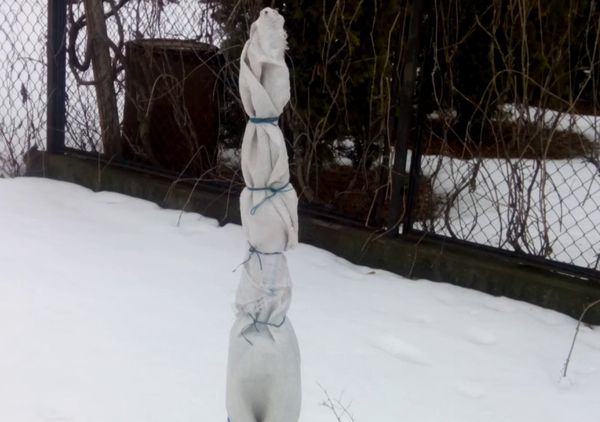

How to insulate apple trees for the winter: cover the seedlings
Hiding apple seedlings differs in its specificity. With the wrong shelter, the tree may simply die. If apple tree seedlings are planted for the winter, they take cover according to the same principle as young trees, but the trunk and crown will require shelter. Before winter, only frost-resistant varieties of apple trees can be planted, if you plan to plant seedlings of other varieties, it is recommended to postpone planting until spring. How to preserve seedlings in winter until spring? There are two ways to do this.
- The first way. You need to choose a dry, windless place on the site. Dig a groove about 50 cm deep, about 35 cm wide. Dip apple seedlings with roots in a clay mash, then place them in the groove. Sprinkle the roots with peat and humus, cover the top with a layer of agrofibre and dry spruce branches. In winter, make sure that the groove is completely covered with a layer of snow. In the spring, when the sun begins to bake, it is necessary to start removing the protection, especially for the snow, so that thin twigs are not damaged under its weight. Remove protection gradually, being careful not to return frost.
- Second way. Choose a dry place, prepare the soil. Add sand to loamy soil, peat or humus to sandy soil. Dig it up thoroughly. Dig a groove from west to east. Carefully fold the seedlings into the groove, making sure that the slope is towards the south, this will provide protection from sunburn. Sprinkle with earth. Water the soil, spread rodent repellent around the groove. These can be branches of rose hips, blackberries. In the spring, you need to make sure that there is not a lot of snow around the groove, otherwise the seedlings will mate. Excess snow at the end of winter is removed as needed.
Seedling protection
Insulation of young apple trees and seedlings is required more thoroughly than adult trees. Varieties of fruit trees that are not resistant to frost can die at the first frost. Frost-resistant seedlings can be planted in late autumn, but in this case, the method of protecting trees for the winter is slightly different from the method of sheltering trees intended for spring planting.
Shelter for the winter of frost-resistant varieties of apple trees
- For the wintering of seedlings, choose a place that will be protected from winds and high humidity.
- Dig a hole (depth - 50 cm, width - 40 cm).
- Lower the root system of the seedlings into a liquid clay solution, only then lower it into the soil and dig in with soil.
- Sprinkle the roots of the seedlings with a mixture of peat and sand, compact the layer, then apply a layer of spruce branches or agrofibre near the trunks.
- During the entire winter time, it is periodically necessary to throw snow to the base of the seedlings.
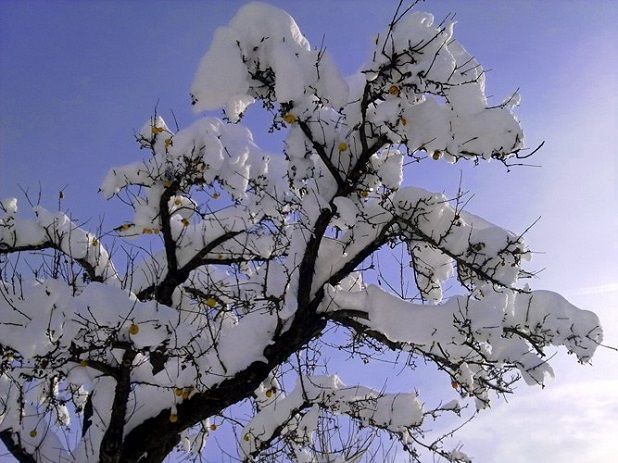

Shelter for the winter frost-resistant varieties of seedlings
- Choose a dry place for planting.
- Dig up the soil, add a mixture of peat and humus to the soil.
- Dig a hole (width - 50 cm, depth - 40 cm).
- Lower the seedlings into the hole, sprinkle with soil, tamp the soil.
- Water the seedlings abundantly.
- Lay the branches of rose hips, blackberries, raspberries in a thick layer near the plants.
- In the spring, when the snow begins to melt, clear the snow near the trunks of the apple trees.
How to cover an apple tree for the winter, depending on the variety
How to cover different varieties of apple trees? The method of shelter depends to some extent on the apple variety and on its characteristics. In general, the shelter technology is similar. When choosing trees for planting, it is important to take into account that some varieties are frost-resistant, but they do not tolerate spring thaws well. It also takes into account in which region of Russia it is planned to plant apple trees, as well as for which region the variety was bred. Frost-resistant varieties are intended for Siberian and northern regions. They do not tolerate sharp warming, and then the return of cold weather.
The varieties bred for the European part of Russia do not tolerate winter well, but sudden warming in the winter time of the day does not frighten them. When sheltering apple trees, you need to approach it taking into account the characteristics of each variety. Some need to pay special attention to the state during periods of thaws, others only during times of low temperatures.
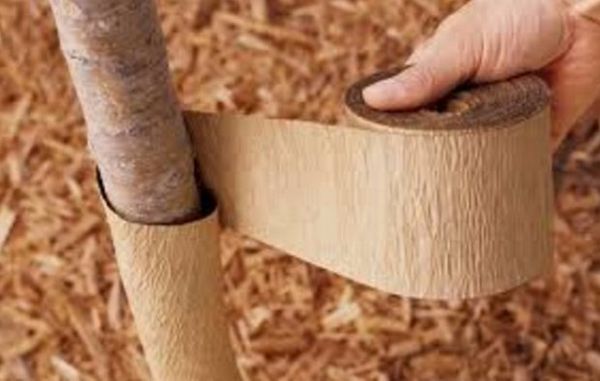

Preparing the garden for winter. Protecting young apple trees
Author on Youtube: smoldacha
Number of views on Youtube 104477
DOWNLOAD How to prepare your garden for winter. Ways to protect apple trees from hares, sunburn, frostbites in winter. How did he take away
Comments on this video:
Latest comments on the site
Thresh Cult of Chucky Movie Review - Watch / Download ⇒ “The Fake Critic has good reviews, despite the fact that they are similar to many others. But it has its own zest, I like it) "Added - TRASH-REVIEW: Battle of Extras (Swindle of All Russia!) - Watch / download ⇒" Are there still people who believe in these screen psychics? I realized a long time ago that this is all a show for an audience thirsting for mysticism and secrets. " Added - Flashmob of fans of the series "Friends" - Watch / download ⇒ "Damn cool peppers were once .... I remember the times when I did not miss more than one episode. Favorite heroes forever remain in the heart "Added - How to Hack Classmates 2020 | Hacking ok - Watch / download ⇒ “People don't get fooled and don't lose your money ...
How to cover columnar apple trees
The columnar apple is a young apple variety that is becoming more and more popular every year. This name was given to the fruit tree for a reason, its appearance resembles a column. The tree has practically no side branches, and the fruits are located along the trunk. A distinctive feature of this apple tree is dwarf growth.
How to insulate a dwarf apple tree? Dwarf apple trees are prone to freezing. After all, near the ground frosts are more severe than at altitude. Special attention should be paid to apple trees of this variety. In such apple trees, the apical bud often suffers. A frost-affected kidney gives rise to several branches, which turn into independent trunks. The appearance of the apple tree is disturbed. To prevent this, you need to cover the crown. Use a film or rag, putting on the covering material on top. It is necessary to cover it with a layer of snow, preparing the columnar apple tree seedling for wintering.
To make the apple tree resistant to gusts of wind, it is recommended to tie a support to the tree. To protect young trees, you need to cover the space near the roots, as the root system can freeze out. You can use straw, shavings, sawdust, spruce branches and other materials. They wrap the trunk with improvised materials: burlap, paper, old rags, nylon stockings, this will scare off rodents. The higher part is wrapped in toilet paper or newspapers.Several layers are made, reinforcing with twine.
With the correct measures for covering the apple trees, the trees will feel good throughout the winter, they will not die or freeze under the covering materials and under a snow coat. In the fall, they will be able to please with delicious bulk apples.
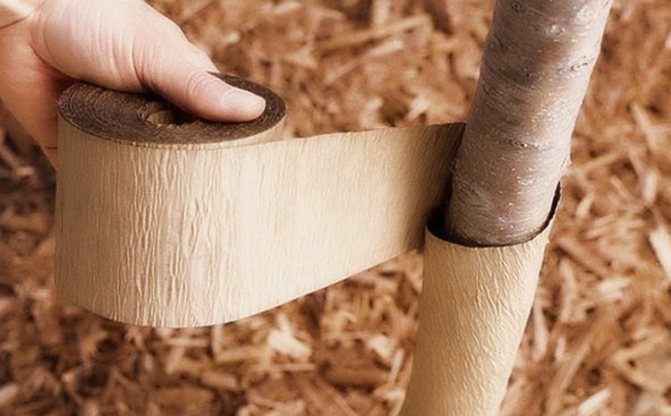

Young apple trees need careful care, especially before cold weather. A few simple guidelines will help gardeners protect these plants from winter damage and speed up their fruiting period.
Shelter timing for apple trees
Depending on the climatic zone, these periods can vary greatly. You need to start covering young apple trees no earlier than the average daily temperature of 10 ° C is established, but at the same time try not to leave trees without minimal protection during the first severe frosts.
Residents of the southern regions should not strongly insulate the trees, as there is a risk of extending the growing season, and, as a result, the death of a young plant. It is enough to protect them from rodents.
The rest of the gardeners should not rush, as covering too early only harms the plant.
Where should you start preparing?
In order for young apple trees to easily survive the winter, they need to be properly prepared. Already in November, before the onset of the first frost, it is necessary to gradually prepare the garden for wintering.
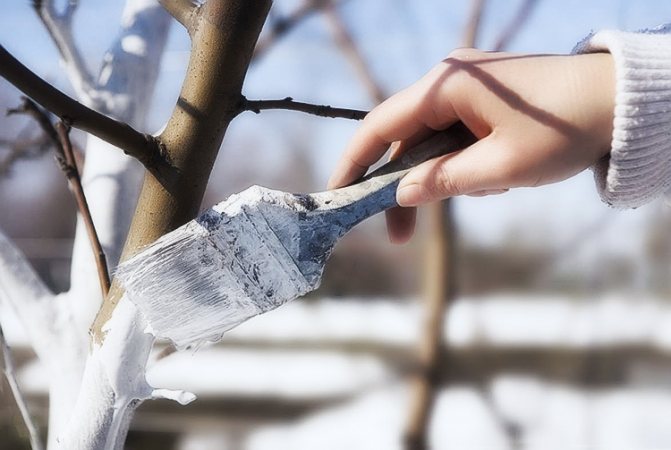

For this you need:
- Remove fallen leaves, branches and rotten fruits. Do not leave them at the roots of the tree - the leaves and old fruits can contain fungi, pest larvae, pathogenic bacteria and other unpleasant things. All of them overwinter well, and in the spring they will begin to harm the plants.
- Process the bark and ground around the tree with a vitriol mixture. Such treatment will help destroy most pests. You can use both copper and iron sulfate, it is also ferrous sulfate.
- Collect bark-grown mosses or lichens (if any). These crops can also severely harm young plants.
- Treat the bottom of the trunk with lime. Many believe that this procedure is carried out only in the spring, but this is not the case. Winter whitewashing is designed to protect the young tree from cracking due to sudden temperature changes and from the last small insects, and also to scare away rodents for a while.
- Form the crown. This is necessary to give the apple tree the correct shape and for the best growth of the tree. The best tool is to use a sharp pruner. The cuts must be made at an angle, so the plant can more easily tolerate a haircut.
- After all the preparatory work has been done, you can cover the plants.
Where to start preparing apple trees for wintering?
The first thing to do after harvesting is to tidy up the garden thoroughly. It is forbidden to allow the accumulation of fallen leaves or other plant debris near tree trunks. It is a mistake to think that foliage can act as mulch.
On the contrary, plant residues can become provocateurs of the development of dangerous diseases, because pathogenic fungi, bacteria and microorganisms "hide" in them. In the fallen leaves, larvae of pests also hibernate, and if you do not get rid of this plant debris, then in early spring all pests will become active and begin to parasitize on plants.
A similar requirement applies to the fruits remaining on the apple trees. All apples are required to be picked from trees. If you leave the fruits for wintering, then they will certainly attract the attention of insect pests who want to find a secluded place for wintering.
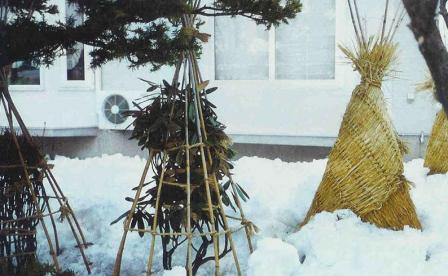

After cleaning the territory, before the onset of persistent frosts, it is required to decontaminate apple tree trunks and soil. An excellent disinfectant is a solution of copper sulfate. The bark of apple trees is sprayed with the prepared solution. For soil disinfection, solutions of copper or iron sulfate are also used.
The next step is to whitewash the apple tree trunks with a lime solution.Whitewashing will serve as reliable protection of the trunks from small insects, as well as sunburn. In addition, the lime mortar will protect the bark of plants from frost cracks that appear on trees due to sudden changes in air temperatures.
Do not forget about mulching apple trees. A thick layer of mulch is laid near the trunks - straw, sawdust, peat. The ideal mulch thickness is 10-15 cm.
The final preparatory stage is pruning branches and abundant watering of apple trees. In autumn, before the onset of stable frosts, the formation of the crown is carried out. The procedure consists in cutting off old and broken branches. The cut tree structures need to be destroyed (burned), as pathogenic fungi, bacteria and viruses can accumulate in them.
For normal wintering, apple trees need to organize abundant watering. A shallow trench must be dug near the trunk of the apple tree, and several buckets of water (about 200 liters) must be poured into it. Repeat the moisturizing soil procedure three times. The moisture accumulated in the root system will help apple trees to survive frosts and abrupt climatic changes with dignity.
Warming process
In order for the trees to winter safely, you need to take care of the insulation of the root system. It is she who is most exposed to frost.
You need to insulate the roots as follows:
- Fertilize the soil around the trunk with manure and cover it with sawdust on top;
- Wrap the area at the roots with an insulating material that easily lets air through - for example, agrofiber;
- Wrap the barrel with paper or some other material.
Use a white material for wrapping the trunk - it reflects well too bright sunlight, which can damage the plant.
If a lot of snow falls, this is a great success for the gardener. The dense snow cover perfectly protects the seedlings from hypothermia, and also interferes with rodents. The snow should be raked closer to the tree trunks and drifts should be formed around them.
Do not be afraid to tamp the snow - apple trees will only benefit, and it will be more difficult for rodents to get there.
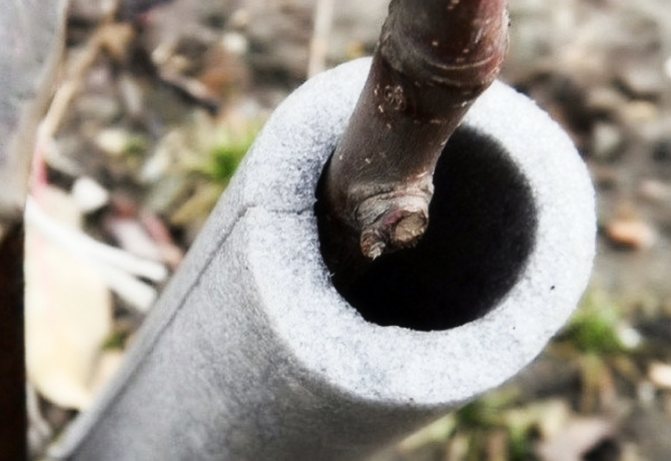

Protecting trees for the winter from frost and rodents
If the site is located near the forest, the problem of rodents cannot be avoided. Hares and mice can become a real disaster for young trees, because they are most often attacked by rodents.
To prevent mice, rabbits and hares from reaching the tender bark of young apple trees, you need to do more than just wrap the trees for insulation. Additional protection will be required.
Necessary materials
For successful rodent control, tree trunks must be properly prepared.
You will need the following materials:
- Insulating material - spruce or juniper spruce branches;
- Strapping material - burlap, non-woven fabric, polyethylene film;
- Plastic or metal mesh for the fence;
- Bordeaux liquid - for the subsequent cultivation of the land after the start of frost.
It will not be superfluous to decompose the poison in mouse and rat holes, since these rodents greatly harm not only plants, but also humans. Therefore, it is better to get rid of them forever.
Be sure to cultivate the land around the trees to prevent rodents from even getting close to the tender bark. Choose mixtures and solutions that benefit the seedlings - the same Bordeaux mixture is great for treating plants.
Shelter technology
Young apple trees prepared for wintering should be carefully wrapped with spruce or juniper branches, while the thorns should be directed downward. You can fasten the spruce branches with ropes. Spruce branches should cover the trunk from the ground and at least 1 m up.
Craftsmen are advised to additionally add something strong-smelling and unpleasant to rodents to the branches. This can be mint or peppermint oil, dog hair, elderberry, creolin, or naphthalene - whichever is in your household supplies.
Next, you need to wrap the trunk with plastic wrap or other selected material - so rodents will definitely not be able to get to the delicate bark.
However, there is a risk of root gnawing and must be dealt with as well. For this, a special fence made of plastic or wire mesh is installed around the tree at a distance of 20 - 30 cm. It must be dug into the ground to a depth of at least 30 cm.
Other methods of rodent control
If the main damage is caused by hares and rabbits, they can be dealt with in the following way: hang rustling black polyethylene on the branches, or pieces of thick cardboard of some bright color. These animals are very shy, and, having noticed movement near the trees, they will hasten to leave.
As another method of rodent control, you can use special repellents. They are easy to make with your own hands - for example, from a plastic bottle and naphthalene - and can also be purchased at specialized stores. These repellents give off a strong, rodent-unpleasant odor and need to be refreshed periodically to maintain their effectiveness.
Choose those products that are not dangerous to humans and pets. It is better to use several methods than one, but the most radical one.
Perhaps all these protective measures will seem superfluous to someone. However, here are a few facts: according to statistics, 60 - 80% of seedlings die from frost in their first winter, and about 90% of properly untreated trees suffer from rodents.
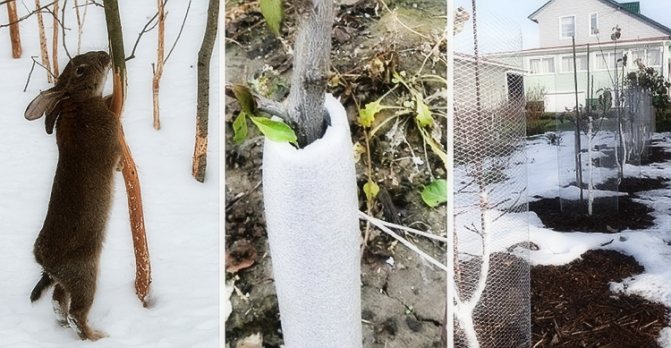

In order for the apple trees to grow healthy and bear fruit for a long time, you must definitely take care of them. And then the harvest will always be high.
Following all the above recommendations, you can correctly and efficiently prepare young apple trees for wintering and successfully protect them from all kinds of pests.
How to protect young trees in winter. Reliable protection methods
When protecting trunks from rodents, almost any material is used. You just need to remember that between the bark and the "non-breathing" material of the shelter, for example, roofing material, you need to make a layer of burlap so that the seedling does not snatch. Therefore, I personally do not really welcome this method.
In our time, a plastic mesh with a small mesh, approximately 6x8 mm, has appeared ... Here you can also wrap the barrel with it. Rodents will not get to the bark through it, it allows the plant to breathe, passes light and preparations for processing, shades a little, but ... it is not so convenient to wrap skeletal branches with it as in tights :))))
If snow falls in winter, then it would be good to throw additional amount of it on the near-trunk circles from the tracks or simply areas that do not need additional shelter. The snow itself under the trees and bushes is a good idea to trample and compact. This will make it more difficult for rodents to break through mink roads in the snow and slow down its melting in the spring. This is important because the warm sun can melt the snow and frost will hit at night. Nice, if small. But we don't know which one.
In addition, the compacted snow will bring additional moisture to the soil during thawing. And if you also scatter mineral fertilizers over the frozen-thawed soil in the spring, they will fall right into the area of the absorbing roots with water.
Whitewashing will also help protect tree trunks from rodents. They don't like harsh chemical odors. Prepare such a whitewash from clay and mullein 1: 1, adding a spoonful of turpentine or carbolic acid. True, such a whitewash makes breathing difficult for plants. Therefore, it is better to dilute 5 g of carbolic acid or creolin in a liter of water and soak the sawdust with it, which is then spread out in the near-trunk circles. Well, mice do not like this smell!
Protecting apple trees from damage by rodents is a basic and important task for every gardener. In addition to hares and wild rabbits, mice do a lot of damage to the future harvest. Often, animals gnaw on young bark, nutritious and readily available, and the roots of fruit trees, in late winter - early spring.We will tell you in the article about the ways in which you can protect apple trees, and what to do if the mice have already gnawed them.
Why do mice like to gnaw the bark of fruit trees in winter? Since in the presence of low temperature indicators on the street, rodents are busy looking for food. They are able to gnaw apple trees only on one side or along the entire diameter of the trunk. This is very dangerous for young crops. Because, if the "clothes" are nibbled along the entire length, it is almost impossible to save the tree. Roots are also very fond of mice, damage to which also poses a threat to the life of the fruit crop.
To protect trees from rodent attacks in winter, prophylaxis is carried out in advance. It includes the fall collection of leaves, weeds, and debris that may harbor pests. Even before winter, you should dig up the entire garden or the ground around the crown of each tree. The depth of digging is observed so as not to damage the condition of the root system. In late autumn or early winter, trees need to be wrapped in protective material.
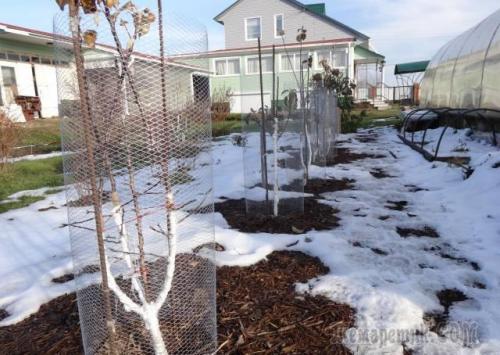

This is done in the area of the trunk - from the ground to the branches. White burlap (aka a plastic bag), agrofibre, even nylon stockings can serve as a protective material. Choose light-colored materials to reduce barrel heat on sunny days. Do not wrap apple trees with straw or other organic materials that favor the establishment of mice in them. Rodents do not tolerate loud sounds, so the use of plastic bottles will be an excellent prevention.
They are cut and hung on horticultural crops. After a heavy snowfall, you should trample the snow near each tree, because rodents get to the apple trees through it. And so you complicate the task of the pests.

